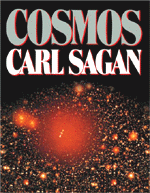Cosmos (Carl Sagan book)

Cover of the first edition
|
|
| Author | Carl Sagan |
|---|---|
| Cover artist | Adolf Schaller |
| Country | United States |
| Language | English |
| Subject | Cosmology |
| Publisher | Random House, New York |
|
Publication date
|
1980 |
| Media type | Print (Hardcover, Paperback) |
| Pages | 365 (first edition) 396 (2013 edition) |
| ISBN | (first edition) 978-0-375-50832-5(2002 edition) 978-0-345-53943-4 (2013 edition) |
| OCLC | 6280573 |
| 520 | |
| LC Class | QB44.2 .S235 |
| Preceded by | Broca's Brain: Reflections on the Romance of Science |
| Followed by | Pale Blue Dot: A Vision of the Human Future in Space |
Cosmos is a 1980 popular science book by astronomer and Pulitzer Prize-winning author Carl Sagan. Its 13 illustrated chapters, corresponding to the 13 episodes of the Cosmos TV series, which the book was co-developed with and intended to complement, explore the mutual development of science and civilization. One of Sagan's main purposes for the book and television series was to explain complex scientific ideas to anyone interested in learning. Sagan also believed the television was one of the greatest teaching tools ever invented, so he wished to capitalize on his chance to educate the world. Spurred in part by the popularity of the TV series, Cosmos spent 50 weeks on the Publishers Weekly best-sellers list and 70 weeks on the New York Times Best Seller list to become the best-selling science book ever published at the time. In 1981, it received the Hugo Award for Best Non-Fiction Book. The book's unprecedented success ushered in a dramatic increase in visibility for science-themed literature. The success of the book also jumpstarted Sagan's literary career. The sequel to Cosmos is Pale Blue Dot: A Vision of the Human Future in Space (1994).
In 2013, Cosmos was published in a new edition, with a foreword by Ann Druyan and an essay by Neil deGrasse Tyson.
Cosmos has 13 chapters, corresponding to the 13 episodes of the Cosmos television series. In the original edition, each chapter is heavily illustrated. The book covers a broad range of topics, comprising Sagan's reflections on anthropological, cosmological, biological, historical, and astronomical matters from antiquity to contemporary times. Sagan reiterates his position on extraterrestrial life—that the magnitude of the universe permits the existence of thousands of alien civilizations, but no credible evidence exists to demonstrate that such life has ever visited earth. Sagan explores 15 billion years of cosmic evolution and the development of science and civilization. He traces the origins of knowledge and the scientific method, mixing science and philosophy, and speculates about the future of science. He also discusses the underlying premises of science by providing biographical anecdotes about many prominent scientists, placing their contributions in the broader context of the development of modern science.
...
Wikipedia
